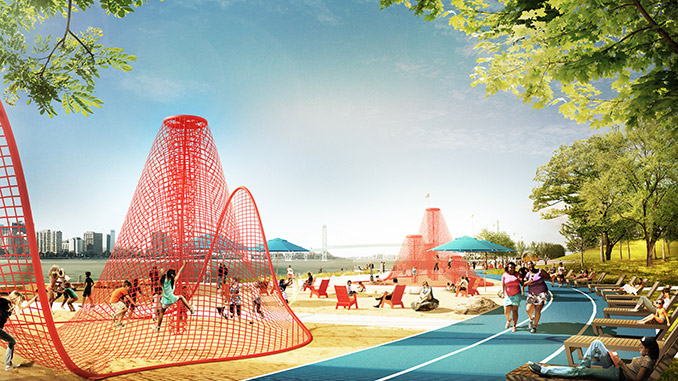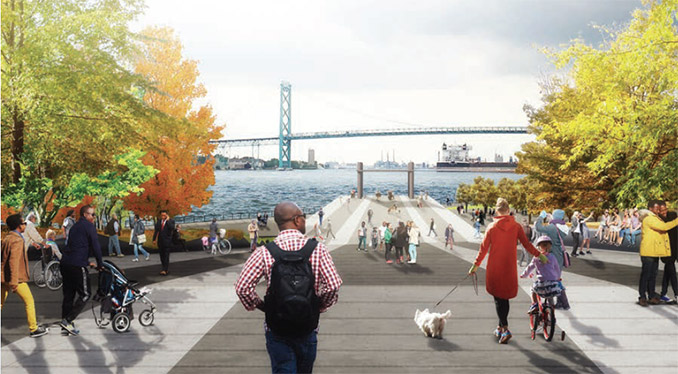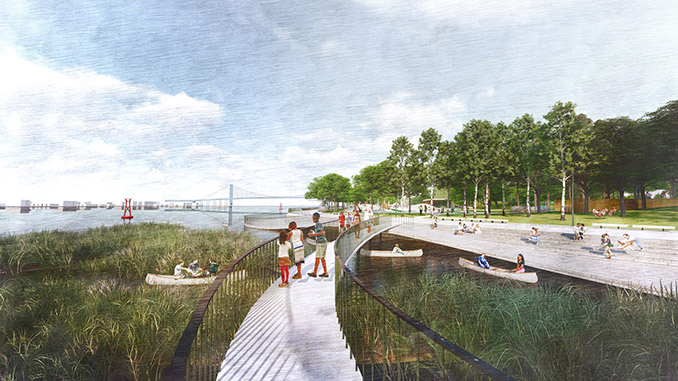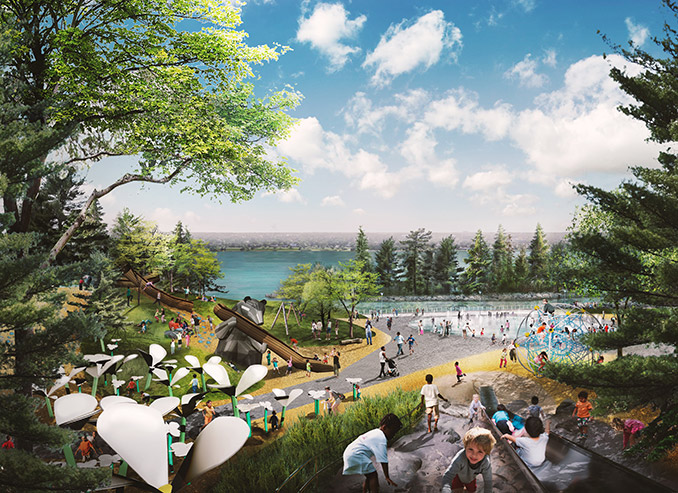

Four design firms recently presented their visions as part of an international design competition led by the Detroit RiverFront Conservancy (DRFC) that will transform the 22-acre West Riverfront Park into one of the most dynamic public spaces in the world. The four principal firms include Gustafson Guthrie Nichol (GGN), Hood Design Studio (HDS), James Corner Field Operations, and Michael Van Valkenburgh Associates (MVVA).


At 22 acres, West Riverfront Park is comparable in size to Brooklyn Bridge Park in New York City, Maggie Daley Park in Chicago and Riverside Park in Buffalo. Development of the park is estimated at $50 million.
The Detroit RiverFront Conservancy’s ultimate vision is for 5.5 miles of revitalized riverfront from “bridge to bridge,” meaning the MacArthur Bridge to Belle Isle on the east and the Ambassador Bridge to Canada on the west. With the East Riverfront more than 85 percent complete, the Conservancy is turning its efforts toward expansion along the West Riverfront, which runs from just west of Joe Louis Arena to Riverside Park, at the foot of West Grand Boulevard.
A $345,000 grant from the Ralph C. Wilson, Jr. Foundation made the West Riverfront Park Design Competition possible. The grant comes from the foundation’s “Livable Communities” focus area that seeks to create strong and sustainable communities by supporting parks, trails and green design.
The competition also features a world-class jury with representatives from the Detroit RiverFront Conservancy, the City of Detroit, the Ralph C. Wilson, Jr. Foundation, and architectural design and planning experts, including Leslie Koch, former president and chief executive of the Trust for Governors Island; Deborah Marton, executive director of New York Restoration Project; Regina Myer, president of the Downtown Brooklyn Partnership; and Deborah Weintraub, chief architect/chief deputy city engineer, City of Los Angeles.
The jury begins deliberating on February 9, with the announcement of the winning team made this spring. Once a team has been selected, the Conservancy will continue community engagement work through 2018 to refine the design concepts.
In addition to hosting several community meetings, the Conservancy assembled a Community Advisory Team (CAT) made up of every-day Detroiters who visited public places in world-class cities like Chicago, New York and Philadelphia so that they could report back on their experiences. CAT members will be on hand to engage with visitors when the public gets another chance to see the renderings and models during a public exhibition from February 10- 22. The exhibition takes place from 11 a.m. to 8 p.m. at 1001 Woodward in downtown Detroit.
The site where West Riverfront Park is located was privately owned and closed to the public for nearly 100 years until the Detroit RiverFront Conservancy purchased the property and opened the park in 2014. Since then, the park has become a popular destination for people to enjoy the outdoors and striking views of the Detroit and the Windsor skylines. The park has also been the site of several large-scale concerts.
In addition to the support received from the Ralph C. Wilson, Jr. Foundation for the design competition, riverfront planning is made possible by the Michigan Department of Transportation, the Fred A. and Barbara M. Erb Family Foundation, Fifth Third Bank, FORD/UAW, the City of Detroit, Hudson Webber Foundation, the Knight Foundation, the Kresge Foundation and the Detroit Metro Convention & Visitors Bureau.
SOURCE Detroit RiverFront Conservancy
Image Credits | As captioned
